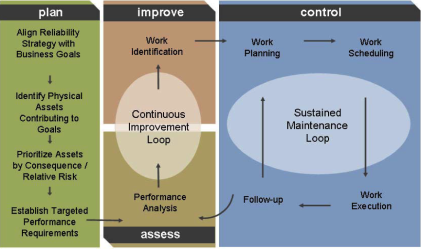
How many organisations really practice Continuous Improvement to their assets and processes?
Reliability-centred Maintenance (RCM) was developed in the Civil Aviation Industry to provide an auditable, structured, objective and scientific methodology to determine aircraft maintenance requirements. The improvement in reliability performance of aircraft over the past 50 years has been nothing short of spectacular.
Auditability and traceability are an important aspect of the way the Civil Aviation Industry does business. If we take the example of an engine blade, records show which forging it was made from, who was involved in each stage of the manufacturing process, who inspected it, who fitted it, etc. This means that if something goes wrong they can refer back and update and improve the relevant processes in the light of the new information. It goes without saying that in order to be able to do this you need to have something to refer back to – in other words, something needs to be written down.
This is the essence of continuous improvement, and the same principles of course apply to industrial processes.
RCM is about the identification of work (‘doing the right thing’) while the Computerised Maintenance Management System (CMMS) and related activities are complementary, because they control the work identified by RCM, and enable measurement of the performance of the overall programme. In other words they are about ‘doing things right’.
Analysis of bad actors, poor performance etc allows the RCM analysis to be re-visited and updated as part of the continuous improvement loop.
But how many organisations ever update their RCM analyses? In how many organisations outside civil aviation, is RCM part of the culture – something people refer to every day?
In some organisations RCM outcomes are not even fully implemented, let alone kept-up-to date. Is it any wonder that sometimes RCM has not given them the benefit they expected?
No RCM analysis is ever perfect, so a system needs to be in place to update it. Furthermore, processes are dynamic – people, raw materials, machines, procedures, performance standards, and cultures change - and all of these factors have an influence on reliability. This means the system needs to consider all causes of failure. John Moubray (2) told us (but many people still fail to take into account in their RCM analyses) that failures come from many sources. This therefore requires all relevant parties to have input to the analysis, which in turn means it needs be accessible to people throughout the organisation. These people also need to have the means to report the potential and functional failures they experience, and a system needs to be in place to make sure these reports are acted upon.
Having all these things in place to build a continuous improvement system is a big ask that unfortunately most companies do not achieve.
DORA (Dynamic Operational Reliability Analyser) provides a revolutionary and exciting solution to this challenge.
- It hosts the process by which the maintenance programme was derived, be it from RCM or a less rigorous approach, while allowing the analysis process used to be tailored to the criticality of the asset.
- It is open, allowing import and export to and from the CMMS, or other sources of information.
- It is web-based so can be viewed by people throughout the organisation.
- It allows people to report potential and functional failures from all causes.
- It shows real-time Paretos of process performance, and potential and functional failures, allowing rectification and improvement work to be targeted.
- It therefore adjusts to changes in processes (people, procedures, inputs, performance standards etc).
DORA facilitates true continuous improvement of assets and processes, allowing the full benefits of RCM - which have so far eluded many organisations - to be realised.
For more information please see:
http://www.reliabilitymanagement.co.uk/services/dora/
References:
1.Ron Thomas and Al Weber http://www.plant-maintenance.com/articles/KPIs.pdf
2.John Moubray RCM2 (ISBN-13: 978-0750633581) P58-64


